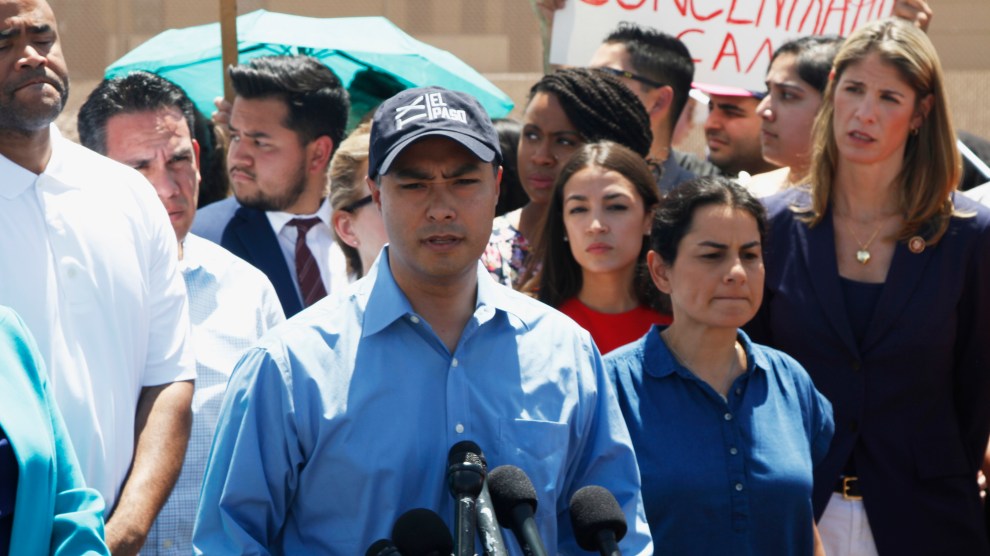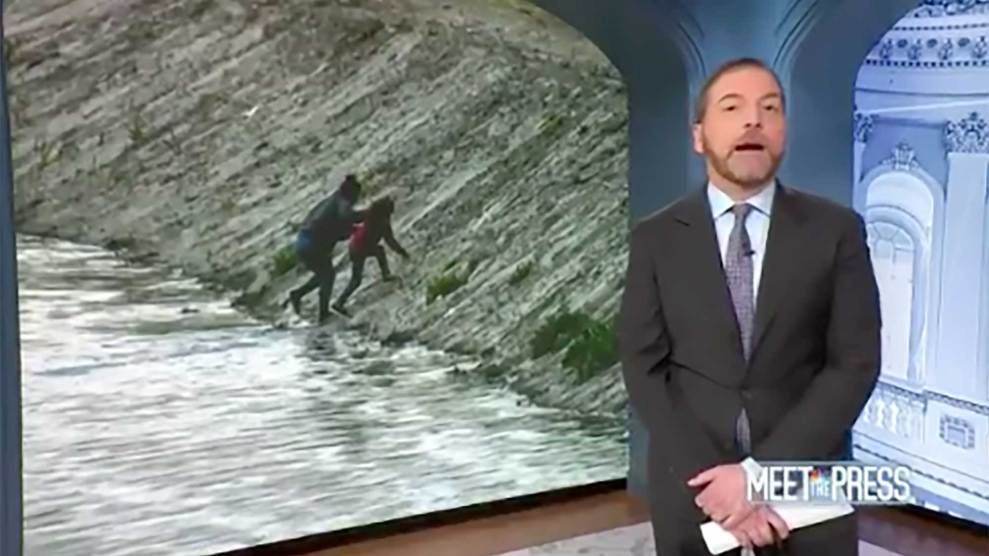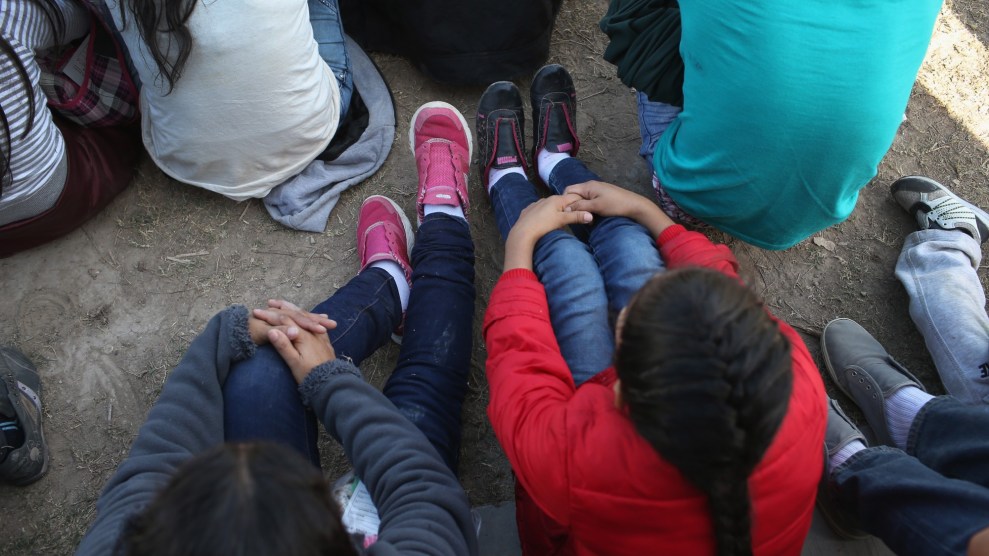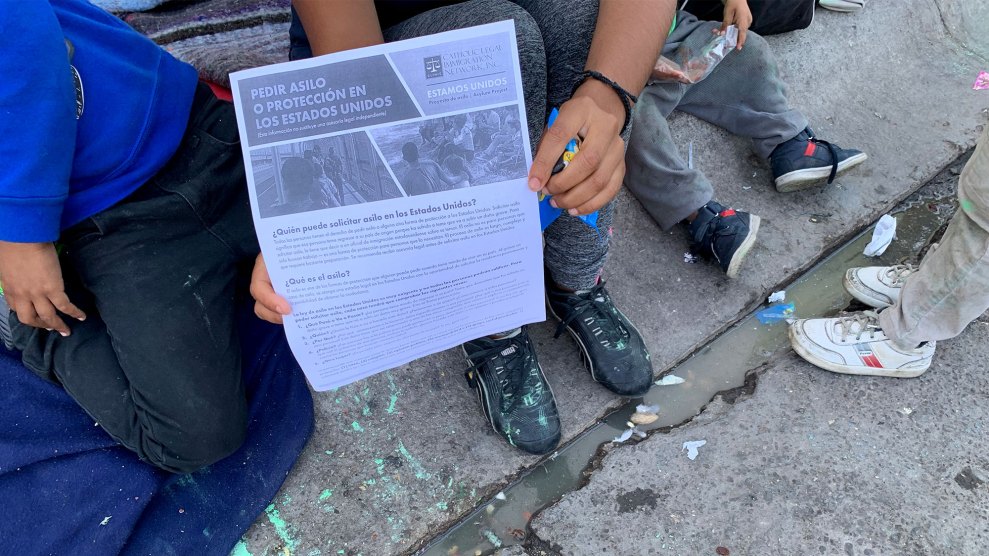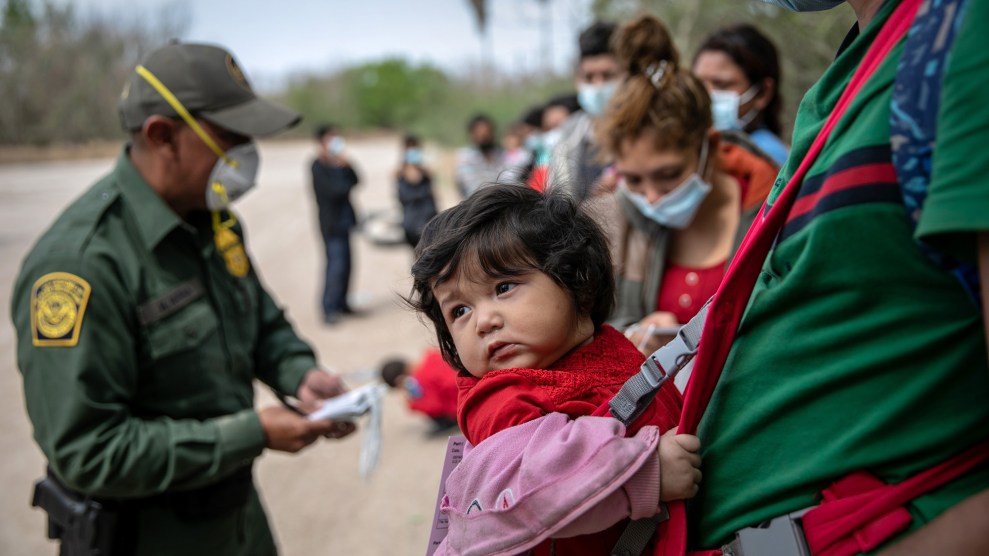
Asylum seekers, including Karli, 4 months, from Honduras are taken into custody on March 25, 2021, in Hidalgo, Texas. John Moore/Getty
For the last few weeks there has been a lot of talk about a “border crisis”—and, of course, if it even really qualifies as a “crisis.” But so much of this conversation is maddening—misleading at best, malicious at worst. Don’t get me wrong: There should be much attention paid to the treatment of vulnerable people in US border custody; families, pregnant women, and little kids are being held outdoors for days under a bridge in Texas (reminiscent of how Trump detained people in March 2019), and US government officials are scrambling to place unaccompanied children out of US Border Patrol custody. For the people held in horrible conditions, for the parents worried about their children in US custody, of course this is a crisis. But for the US government, this year’s influx is not an unprecedented set of circumstances; we’ve been here before and we should’ve been better prepared.
Some immigration advocates have been noting this for days and criticized the sudden media hysteria around what’s happening at the Southern border. Human Rights First, a nonpartisan nonprofit organization, went as far as to put out a statement condemning some of the recent reporting from the Washington Post, the New York Times, and Axios. In an unusual move, the organization said these outlets “have appeared to be in a disturbing competition to be the first to decisively demonstrate that the Biden administration’s rollback of cruel and illegal Trump-era immigration policies is a disaster of mammoth proportions.” They singled out a recent Washington Post story that quoted Stephen Miller, Trump’s white nationalist immigration adviser: “His record is one of hatred and cruelty; his opinions on immigration reflect that, and should be valued by absolutely no one. Equally stunning, his views on immigration are explored only around how he hopes they will play in the 2022 midterm elections.”
In all this, a few crucial points are getting lost in, or twisted by, the national conversation. This week, I spoke with a couple of experts on border and immigration issues to bring much-needed context to the numbers, and to note differences in what we’re seeing today, as the number of families and unaccompanied minors in the custody of Border Patrol and Health and Human Services continues to rise. And, again, while we should absolutely scrutinize the inhumane conditions in Border Patrol holding cells under Biden, just as we did under Trump, maybe the bigger issue is that we’re almost certain to have to do this again under whoever is in charge next. So perhaps the more important question should be why the US government seems to be caught off guard every time there is an increase of migrants at the border—and what officials will do to better respond to this in the long term.
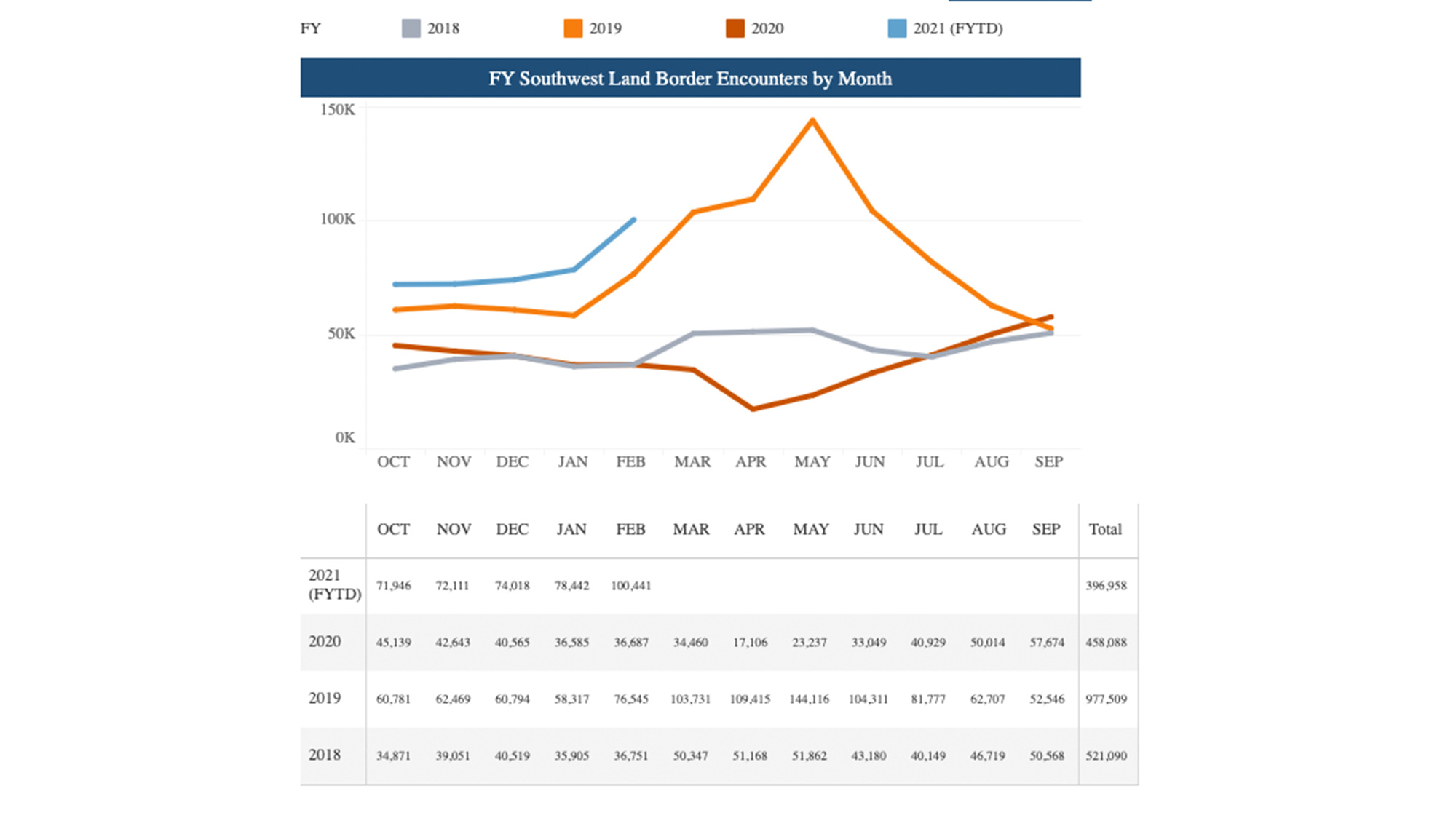
Number of encounters at the US-Mexico border by fiscal year.
US Customs and Border Protection data
Critics keep harping on Biden’s messaging. But, ultimately, messaging just doesn’t make a huge difference.
There are many people, and in particular many elected Republicans, making the case that Biden’s approach to immigration, both by eliminating some—key word being some—of the cruel policies at the border and by saying he wants to create a “humane” immigration system, is sending a message to migrants to pack up and make the trek north. And while that may be true for some people, the numbers we’re seeing are not the result of messaging alone. “Messaging has an impact, but I cannot think of it as having a determinative impact,” says Yael Schacher, an immigration historian and senior US advocate at Refugees International.
If the words and policies of a US president, whoever they may be, had such a huge influence on flows of migration, then how do you explain 2019? Trump was in office and he had already shown from day one that he was anti-immigrant and that he would do whatever he could to keep people out of the country. Yet, with some of the most anti-immigrant messaging in generations coming out of the White House, 2019 saw some of the largest numbers of people at the border in recent history.
“This was after Trump had already shown that he was willing to rip parents and children apart,” Aaron Reichlin-Melnick, policy counsel at the American Immigration Council, says. “So the idea that Biden saying ‘I’m going to be slightly nicer’ is single handedly enough to set off a run on the border ignores the fact that under Trump, we had a president who was willing to say, ‘If you come to the border, I will inflict cruelty on you,’ and yet people still came.”
Biden in fact brought this up on Thursday, during his first press conference since taking office. Early on he was asked about the situation at the border, and when a reporter said Biden’s repeated message of “don’t come to the border now” was not being received, and that instead people are coming because he’s perceived as a “moral decent” man, Biden joked: “I guess I should be flattered people are coming because I’m the nice guy.” He went on to ask if anyone had blamed Donald Trump when there was a 31 percent jump in border apprehensions from January to February 2019—a bigger increase than the 28 percent rise in the same period this year.
Historically, Schacher adds, there was no question that “people knew in the 1980s that the Reagan administration did not consider Guatemalans and Salvadorans true refugees, but people still came.” The Obama administration was also explicit in its message, she notes: “Jeh Johnson was extremely clear about trying to send deterrent language, about not coming, about the border being closed, that you’d be turned away,” and hundreds of thousands still came.
Most people migrate regardless of what’s being said in the United States because they’re in extreme circumstances.
What’s more, there’s a major conflict with the messaging, Schacher says, because if the president says the border is closed, but the law says there are in fact ways in which people fleeing persecution can seek asylum at the border, those are working in opposition to each other because seeking asylum is legal.
So in the end, a few radio or Facebook ads telling people not to migrate don’t really matter.
Harsh Trump administration policies created an immense backlog at the border.
For decades there have been many push factors behind someone’s decision to leave their home and embark on a dangerous, long, and expensive journey to uncertainty, with hopes for safety in the United States. And this time is no different. People have fled extreme circumstances as victims of extortion, corruption, gender-based violence, persecution, political unrest, extreme poverty, and natural disasters that have been exacerbated by climate change—most recently a devastating hurricane in Honduras that left people with nothing.
One of the reasons 2021 is different is that for the last two years, Trump policies forced tens of thousands to be stuck in Mexican border towns—first under the “Remain in Mexico” policy in 2019, and then in 2020 with Title 42, under which Trump used the pandemic to close the border to all migrants and asylum seekers. It’s not like all the migrant families we’re seeing at the border today packed up and left their homes in Central America or Mexico after Biden became president. Many had already been at the border, becoming more and more desperate over the last year.
Julia Neusner, a legal fellow at Human Rights First, has been talking with people in Tijuana this week, visiting shelters and a camp set up near the border. At the tents set up closer to the port of entry, most of the people she met had arrived within the past few months, and many knew the border was closed but were camped out there in hopes the border will “open” and they can be first in line. This belief is coming from some of the rumors that inevitably spread when there’s a lack of clarity about what’s going on. But she also went to a shelter where 27 Haitian asylum seekers told her they had arrived last year and had been waiting at the border since because it has been closed under Title 42.
So yes, while it’s correct to say people have arrived in recent months and will continue to arrive in the coming months, remember the backlog—and that this movement is right on trend with historical migration patterns, in which migration speeds up in the spring and slows down in the summer and winter.
The majority of people encountered at the border has been single adults, a trend that started to grow the moment Trump instituted Title 42 in April 2020. “Tens of thousands of people were being turned away at the border under Title 42, so there was no sudden increase in people coming that just began on Inauguration Day,” Reichlin-Melnick says. Plus, many people are being counted more than once, as they try to enter the country again shortly after expulsion.
The number of families and unaccompanied minors has also been rising since the spring of 2020, but at a slower pace. That pace has changed recently, speeding up—in part, Reichlin-Melnick says, because of a year of Trump policies, including Title 42, that turned away tens of thousands of asylum seeking families. This built “a demand to access what is their right under US law,” he notes. And that is another key point: It is their right under the law. Schacher tells me that thinking about the number of people at the border as a crisis is clearly “not new framing, but it’s one that doesn’t acknowledge the very basic legality of seeking asylum, and instead focuses on how the border should not be a place where people can seek asylum.” For much of the last year, the border “was closed to migrants seeking asylum under Trump and it remains closed to asylum seekers under Biden, so people are trying to enter without authorization if they want to seek asylum. But under our laws, what should happen is that people should be able to seek asylum at the ports of entry.”
On unaccompanied migrants specifically, what Biden is doing by letting unaccompanied minors enter the United States is the norm, not the exception to the rule. For decades, when US border officials came in contact with a minor who was traveling without a parent or guardian—which defines them as Unaccompanied Alien Children under US immigration proceedings—officials didn’t turn the child away. Trump heavily relied on the Mexican government to slow and stop the arrival of more unaccompanied children at the US-Mexico border, and the US administration later began ignoring the law that says kids can’t be turned away at the border if they’re alone. But in mid November 2020, a judge ordered the Trump administration stop expelling unaccompanied children under Title 42, so since then the number of children entering US custody has been increasing.
“The Biden administration was faced with the choice of whether to go back to the practice of expelling unaccompanied children in violation of the law” or allowing them in, Reichlin-Melnick says. “They chose to do the right thing, which was to follow the law and follow our promises not to send children to places where they may face persecution. And that’s a decision that should be commended.”
As Jennifer Podkul, vice president for policy and advocacy at the national organization Kids in Need of Defense (KIND), noted in an interview with my colleague Isabela Dias earlier this month: “In 2020, unaccompanied children were told that they were not allowed to ask for protection in the US, and if they ever tried to, they were dumped in Mexico. There was this artificial backlog of children who had been waiting in Northern Mexico. We knew that when Title 42 was repealed for kids, whether through a court process or a new administration, there would be a pressure valve that needed to be released.”
And that’s what we’re seeing now. There is a clear rise in the number of kids that US border officials are encountering, more than 10,000 in the last month; what’s perhaps getting the most attention, which is warranted, is that almost half of them are still in custody of Customs and Border Protection. There has been a loud cry for CBP to follow policy and not hold children for longer than 72 hours, but that continues to happen, even after 2014 when we we saw the conditions inside Border Patrol holding cells near the border. DHS Secretary Alejandro Mayorkas himself said this month that these facilities are no place for children and that the Biden administration will work as fast as possible to get the kids into HHS shelters ahead of reunification with family members or sponsors.
Biden’s policy changes and executive actions have so far had little effect on the increase of encounters at the border.
In his first week in office, Biden directed DHS to stop placing people in the “Remain in Mexico” program, officially known as Migration Protection Protocols, which was mostly a symbolic move. The program, started by Trump in 2019, had forced about 70,000 asylum seekers to return to Mexican border cities to wait out their asylum cases as they moved through the US courts. But since the beginning of the pandemic, only 1 percent of people who were seeking asylum were placed under MPP, Reichlin-Melnick says. So Biden ending that program did not do much to change the actual number of migrants and asylum seekers encountering border officials in the last few months.
What did change, and this is separate from the “crisis” at the border right now, is that Biden set up a system to slowly bring in about 25,000 of those asylum seekers who still had a pending active case under MPP. We’re talking about a thousand Central American families so far who had to sign up through an online portal to receive a date and time to show up for a COVID test in Mexico, then be processed at their scheduled time by US border officials, tested for COVID again, and then allowed to travel to their final destination in the United States to connect with their family members or sponsors. They will now attend check-in appointments at the local ICE offices and their cases will continue at their closest immigration court. But this separate process is not adding to the rising numbers reported by CBP.
Another Trump-era policy that Biden ended was the so-called Asylum Cooperative Agreements with Guatemala, El Salvador, and Honduras. These were meant to limit migrants’ access to asylum in the United States and ending these agreements “had literally no effect on the border,” Reichlin-Melnick says. That agreement with Guatemala had been suspended since March 2020, and the ones with El Salvador and Honduras never went into effect. So the thought that ending this policy sent people to the border in recent months doesn’t really make sense.
The bottom line, says Reichlin-Melnick, is “there is no clear evidence that any Biden policy is making much of a difference.” And as Neusner tells me from Tijuana, “Most of the people I talked to there were fleeing pretty urgent situations in their home counties, and I didn’t get the impression that the change in administration had anything to do with their decision to come.” 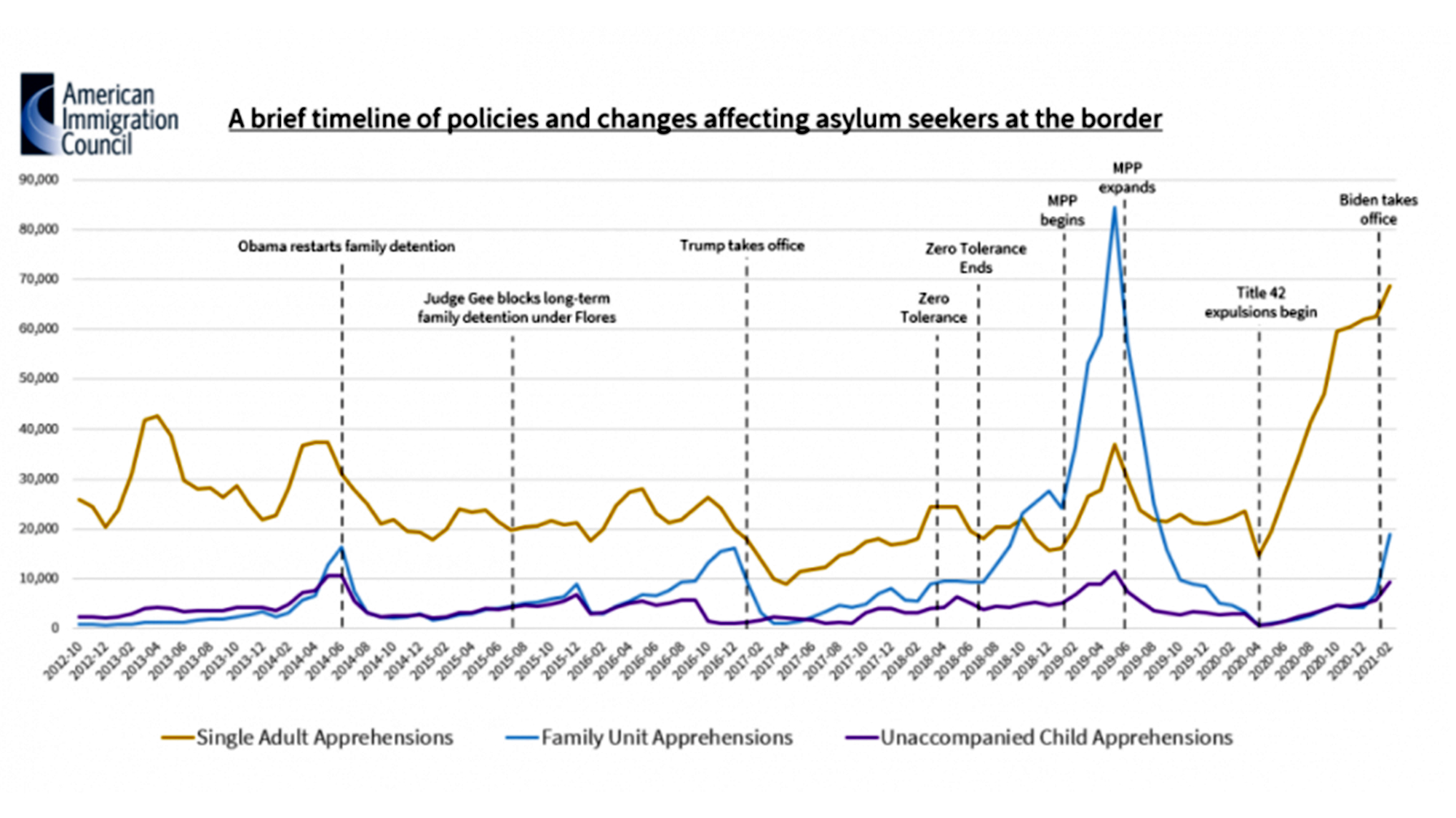
Timeline by the American Immigration Council, a nonprofit advocacy group.
American Immigration Council
What Biden has not revoked is Title 42, the most significant Trump-era change to the border since the pandemic started, and which continues to quickly expel most people who are crossing the border in between ports of entry. (It’s also worth noting that while the border is closed to migrants, it’s been open for a million people to go back and forth for trade, business, and vacations.) The Los Angeles Times recently reported that in a year of Title 42, of more than 650,000 encounters with migrants at the US-Mexico border, fewer than 1 percent have been able to seek protection.
We’ve been here before. The US government—and many in mainstream media—should stop being caught off guard by migration patterns. Instead, they need to be prepared.
When it comes to the rise and fall of the number of migrants at the border, especially children, the US government seems to suffer from amnesia and scramble every time there is a “crisis.”
The reality is that for more than a decade we’ve seen increases of unaccompanied minors at the border. Even ahead of the 2014 “crisis” under Obama, government officials were made aware that a large number of kids would be coming and they were ill prepared. For the last decade “we’ve never had a year of fewer than 40,000 unaccompanied kids, so one would think that we would now understand that we are going to get tens of thousands every year unless we do something substantially different in their home countries or with a refugee resettlement program,” Schacher tells me. We’ve done essentially nothing to create a system that makes it so that every year we don’t have to create influx shelters for children, she adds.
Not only are government agencies unprepared, the politics around this are nothing short of opportunistic. In the last couple of weeks, Republicans and Democrats have traveled to the border, providing the American public with two versions of reality. Republicans, some dressed up like they’re headed for a warzone, conveniently say that migrants held outdoors under a bridge is Biden’s crisis, when we saw Trump doing the same thing two years ago. Democrats, meanwhile, were very vocal about the conditions inside detention facilities for families under Trump, but are not pushing for the Biden administration to stop building influx facilities, which, while better, have had their own share of problems.
We keep seeing similar border “crises” over and over because “we haven’t set up a processing system at the border that’s really viable, or a screening mechanism that’s actually fair, or a court system that’s actually functional,” Schacher says. “It’s a failure of vision and I think it’s partly politically motivated with a refusal to address in our immigration system writ large.” As Reichlin-Melnick notes, “Unless we invest in our capacity to handle families and children safely and humanely when they come to the borders, we’re going to see this again in 2022, 2023, and so on into the future.”
In order to not find ourselves in this place again, Schacher says the US government needs to start accepting the new realities and demographics of migration, and planning for them. Not only that, but the Western Hemisphere needs to also have a refugee resettlement program the way the United Nations High Commissioner for Refugees works in other parts of the world—for example, she notes, someone fleeing Somalia can apply for refugee status in the United States when they get to Kenya. The system is not set up like that in the Americas (though there is a very small program in Costa Rica, but at a minimal scale). “We can’t say people should seek asylum close to home so they don’t have to take the dangerous journey if there isn’t a way to do that,” she says.
“It’s important to add that 600,000 families and unaccompanied children arrived at the US-Mexico border in 2019, and a large number of them were admitted into the United States, yet the sky hasn’t fallen,” Reichlin-Melnick says. “As a nation, we have absorbed periodic waves of refugees from countries around the world over the last 40 years, from Haiti, from Cuba, from Vietnam, from Cambodia, and now from Central America. So in many ways, I think that people need to recognize that the United States is not going to collapse because we open our arms and fulfill our promises to a few families and children arriving at the border.”
Above all, though, what’s most critical moving forward is that we don’t forget “the humanity of the people who are coming to the border,” Reichlin-Melnick says. “Those who are being described as hordes are families, children, and adults who are just doing what so many millions of people have done before them, which is see the United States as a place where they can have a better life and try to make their way here for safety.”

